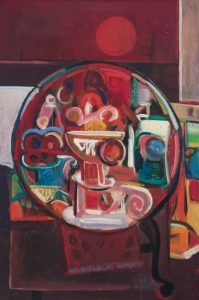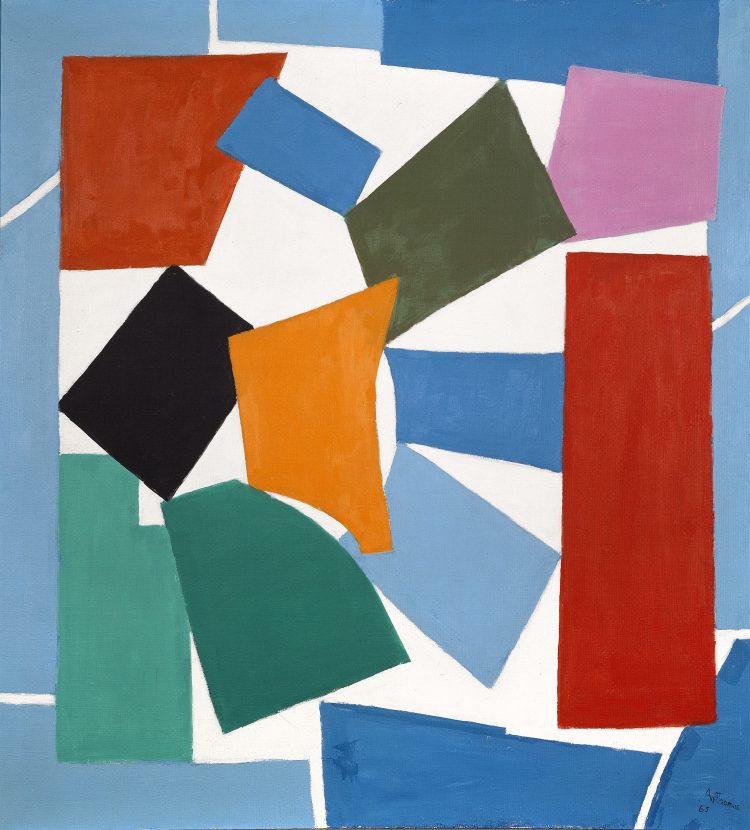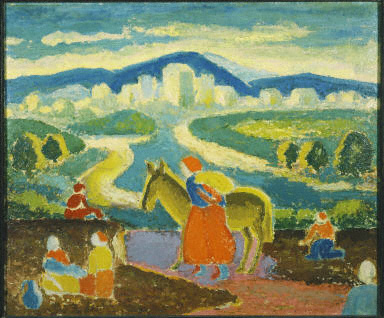During and after the Great Depression and World War II, when fewer museums dotted the local landscape, Duncan Phillips (1886–1966) joined forces with cultural leaders like James V. Herring (1887–1969) who opened the Howard University Gallery of Art in 1930, and Alonzo J. Aden (1906–1961), who with Herring in 1943 opened in their home the Barnett Aden Gallery, the first black-owned commercial art space in the US.
Herring and Aden championed Phillips’s efforts to bring modernism to a wider audience. They valued his emphasis on the innate visual relationships found in art, and his belief that works should be displayed in intimate settings, ideas they interpreted in their galleries. As they developed their collections, Phillips, Herring, and Aden supported many of the same artists and acquired examples of their work. They crossed racial boundaries, forged collaborations, exchanged art loans, and fortified a professional and collegial relationship. Together, they endorsed local artists and incorporated diverse voices, helping to make art more accessible and shaping the cultural landscape of this city.
Riffs and Relations: African American Artists and the European Modernist Tradition features several artists associated with these three cultural institutions:

David C. Driskell, Still Life with Sunset, 1966, Oil on canvas, 48 x 32 in., Collection of Joseph and Lynne Horning
David C. Driskell studied art at Howard University and Catholic University. While at Howard, he began visiting The Phillips Collection, where he enjoyed seeing in the galleries works by American and European modern painters. Driskell recalled his early visits: “I just felt a sense of welcome there . . . Washington was still a segregated city [but] . . . I felt accepted at the Phillips . . . [I would] walk down the hall and see a Cézanne, and a Rouault, and come down the steps, and there would be [a] Marjorie Phillips . . . and [a] Pippin . . . I could go there and see great art and feel I might become part of this.” Driskell would later bring his Howard art students through the galleries of the Phillips.

Alma Thomas, Watusi (Hard Edge), 1963, Acrylic on canvas, 47 5/8 x 44 1/4 in., Hirshhorn Museum and Sculpture Garden, Smithsonian Institution, Washington, DC, Gift of Vincent Melzac, 1976
Alma Thomas, the first fine arts graduate of Howard University, accompanied Driskell on visits to the Phillips, especially on Sundays for the concerts. They became associated with a new generation of artists encouraged by the cooperative interactions of Washington’s cultural leaders. After graduating from Howard, Thomas began teaching art at Shaw Junior High School. She brought students to various cultural institutions, including the Central Public Library, the Smithsonian, the Corcoran, and the Phillips. In the 1950s and 60s, the large-scale abstractions by Washington Color School painters—Kenneth Noland, Gene Davis, Morris Louis, and later Thomas and Sam Gilliam—permeated the local art scene. Phillips, Herring, and Aden promoted, collected, and exhibited works by these artists.

James Lesesne Wells, Primitive Girl, 1929, linoleum cut, 7 ½ x 7 in., David C. Driskell Collection, Permanent loan to the David C. Driskell Center at the University of Maryland, College Park
Renowned for his work during the Harlem Renaissance, James Lesesne Wells was also an educator, painter, printmaker, and designer who mentored many students during his 39-year tenure at Howard University in the art department. Primitive Girl shows the artist’s engagement with African art and expressionist printmaking techniques. Phillips acquired Wells’s Journey to Egypt in 1931, making it the first work by an African American artist to join the museum’s collection.

James Lesesne Wells, Journey to Egypt, 1931, Oil on canvas mounted on cardboard, 13 3/8 x 15 7/8 in., The Phillips Collection, Acquired 1931

Loïs Mailou Jones, Place du Tertre, 1938, Oil on canvas, 18 1/4 x 22 5/8 in., The Phillips Collection, Acquired 1944
In 1930, James V. Herring recruited Loïs Mailou Jones to teach at Howard University, where she would remain an art instructor for the next 47 years. In 1937, she received a yearlong fellowship that brought her to Paris, where she painted still lifes, portraits, and street scenes in an Impressionist style like this example. She began exhibiting her art at the Phillips in the 1940s during the Christmas Sales Exhibitions, which premiered the work of local artists, who received all proceeds from the sales. Jones, who was friendly with Phillips, felt that these shows provided “a wonderful opportunity for young artists to exhibit in a first-class gallery.”
In this spirit, we invite Howard University students and staff to visit Riffs and Relations for free on Saturdays and Sundays with Howard ID.
